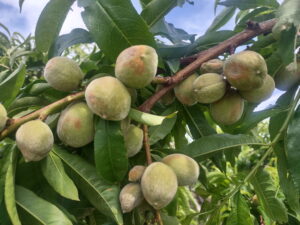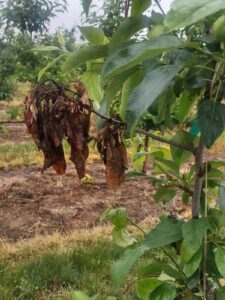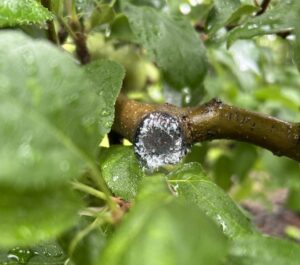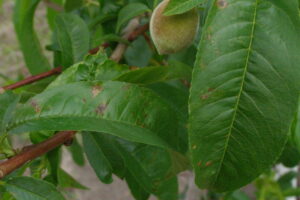
Fruit Crops Edition
Seasonal updates on diseases, insects, weeds impacting tree fruit and small fruit (blueberry, cranberry, and wine grape). Fruit Pest Alerts are also available via this category feed.
Subscriptions are available via EMAIL and RSS.
Agritourism Marketing Survey
WVU Extension and other colleagues are trying to understand how we can better help you with your Agritourism Marketing. It will tremendously help us to help you in the future.
Please take a few minutes (at most 5 minutes) to answer the questions here: https://s.uconn.edu/agritourism-marketing
Fruit IPM Report June 11, 2025
Peach:
Bacterial Spot: Fruit symptoms are very low and only in highly susceptible varieties. Growers should continue to manage using Oxytetracycline and lower rates of copper, especially around rainy periods and severe weather. Fruit will become less susceptible to infection at pit hardening which is occurring now.

Figure 1. Rusty spot on peach. Photo by Karlton Raines-Neidigh.
Rusty Spot: Rusty spot infections are appearing on fruit in Northern and Southern counties and ongoing until pit hardening (Figure 1). Maintain coverage with effective materials such as Rally, Rhyme, or potassium bicarbonate products. Other choices include Flint Extra, Inspire Super, and Luna Sensation.
Peach Scab: Maintain good coverage with captan or other effective fungicides until July in orchards where scab was an issue last year.
Oriental Fruit Moth: A biofix point for OFM was set on 4/2 for southern counties and 4/17 in northern counties. Treatment timings targeting the second generation are shown in the table below.
| OFM 2nd Generation Timing | ||||
| Insecticide Type | ||||
| County/Region | Degree Days by 6/11 base 45 | Conventional
1150-1200 1450-1500 |
Intrepid/Rimon
1050-1150 1300-1400 |
Diamides/Virus
1075-1150 1375-1450 |
| Gloucester – Southern | 1145 | 1st –June 11-13
2nd – too far off |
1st –June 8-11
2nd – too far off |
1st –June 9-11
2nd – too far off |
| Middlesex – Northern | 1001 | 1st – too far off
2nd – too far off |
1st – June 13-17
2nd – too far off |
1st – June 14-16
2nd – too far off |
Tarnished Plant Bugs; and Other Catfacing Insects: Catfacing insects are active, and activity is increasing with dry weather and summer temperatures. Very little recent fruit feeding has been observed.
Green Peach Aphid: We are observing reduced aphid counts across farm sites. If more than 1 colony of aphids are found in nectarines, or 2-3 colonies are found in peaches, an insecticide for aphids is needed. See the NJ Commercial Tree Fruit Production Guide for recommended materials and rates.
Scale Insects: White peach scale and San Jose scale crawlers began emergence around May 26 and will continue emergence for up to 6 weeks. Control options during crawler emergence include Noenicitinoids (suppression only), Sivanto, and the IGR’s Esteem and Centaur. See the NJ Commercial Tree Fruit Production Guide and the product labels for more information.
Apples and Pears:
Diseases: Now that primary scab is nearing the end, or has ended, the focus turns toward summer diseases such as fruit rots (esp. Bitter rot), and sooty blotch and fly speck. Bitter rot control has been difficult at best in recent years even where management programs have been rigorous. Research has suggested Products such as Merivon, Luna Sensation, Inspire Super, Omega, and Aprovia may be effective, and longtime reliable broad spectrum fungicides such as captan and ziram should provide control. Experience has suggested that the addition of phosphorous acid products such as Prophyt or Rampart to captan sprays may improve control. Observations are that these products improve control of other summer diseases such as sooty blotch and flyspeck, and may help suppress scab infections where present. Scab symptoms are appearing in some orchards statewide.

Figure 2. Fire blight strike in apple. Photo by Karlton Raines-Neidigh.
Fire Blight: Fire Blight symptoms began appearing in southern county apple orchards the week of 5/19, and we are seeing a significant increase in infection across the region (Figure 2). Typically it is recommended to cut out infected limbs however this is a practical decision that must be made.
This blog post from Michigan State may be helpful to decide whether it is worth cutting out infected tissue. Once the terminal buds set, typically in July, infected wood should be removed to prevent colonization by the bitter rot pathogen.
Codling Moth (CM): A codling moth biofix was set in southern counties on 4/28 and in northern counties on 4/30. Trap captures have decreased. The timing for codling moth applications for the first generation have passed in southern counties and is wrapping up in northern counties this week.
| Codling Moth Degree Day Timing | |||||||||
| Application and Insecticide Type | |||||||||
| County Area | Biofix | Rimon:
75-100DD + 14-17 days later
|
Intrepid
150 + 450 DD Diamides – Altacor, Voliam mixes: (150-200 DD) |
Madex
250 DD + every 7-9 days during brood hatch (later if first spray is an IGR) |
Standard Insecticides – Delegate, Avaunt, OP’s, carbamates, pyrethroids
250 DD + 550 DD
|
||||
| DD | 75 | 100 | 150 | 450 | 250 | 250 | 550 | ||
| Southern | April 28 | past | past | past | past | past | past | past | |
| Northern | April 30 | past | past | past | past | past | past | June 10 | |
Ambrosia Beetle : Infested trees are showing signs of stress. If you have had a history of this pest in your orchard, now is a good time remove and burn any trees that have been attacked as the flight appears to be declining or is over.
Wooly Apple Aphid (WAA); Green Apple (Spirea) Aphids (GAA): GAA colonies are being observed, some above threshold in some apple blocks. GAA is generally a pest that can be tolerated in orchards where beneficial insects are present. Generally treatment thresholds for GAA are if 50% of the shoots are infested where no beneficial insects are present. WAA aerial colonies are also forming in orchards statewide (Figure 3).

Figure 3. Wooly apple aphid colonizing pruned wood.
The best control for WAA is Movento applied before or when the first colonies appear. Diazinon is also effective at knocking down infestations. Movento will also control GAA and should control San Jose scale when applied in mid-May, and suppress scale when applied in late May or early June. Do not combine diazinon, oil, or oil based penetrants with Captan.
Pear: Pear psylla are still actively laying eggs and nymphs continue to hatch. Options for control include spinosyn products such as Delegate and Entrust, and the neonicotinoids (IRAC group 4A). The addition of 0.25-1 gal of summer oil may improve control. Other options include Movento, the IGR’s Esteem and Centaur, and products containing abamectin. Be sure to read and follow the label instructions regarding the addition of penetrants for abamectin products, and Movento.
Grape: Grape diseases active at this growth stage are phomopsis, powdery mildew, downy mildew, and black rot. Disease infection periods can be monitored using the NEWA models. Choose the weather station closest to your vineyard. The biofix in southern counties for GBM was 5/24. Model timing will predict IGR and diamide materials for the second generation. The first generation is not really important in cultivated grapes, and the timing for the second generation treatments using Diamides or Intrepid is set at 810 degree days base 470F. Other materials may be applied a few days later. Given the current weather patterns, this should be about the last week of June in southern counties. The model works best when growers record their own bloom dates and use the Grape Berry Moth model at NEWA.
Blueberry: Spotted-wing drosophila (SWD) was found on traps placed in both Atlantic and Burlington Counties last week. Oriental beetle (OB) captures were reported in low numbers in Atlantic County last week. For weekly reports on blueberry pests and recommendations read the Rutgers Blueberry Bulletin.
The weather this season has been particularly wet, which can be a positive for plant vigor, but can complicate pest management. Recent pesticide applications may be washed off by rainfall, leaving fruit vulnerable to infestation. Supplemental treatments should be considered when rain washes off existing sprays, especially as we approach harvest of fruit crops to maintain coverage during this critical time. Additionally, rotating chemistries as much as possible helps reduce resistance risk. This blog post from Michigan State University contains valuable information on wash-off potential of insecticide residues after a rain event for various fruit crops.
Phenology Table: Based on annual observations made in Gloucester County.
| Pest Event or Growth Stage | Approximate Date | 2025 Observed Date |
| Bud Swell (Redhaven/PF-17) | March 23 +/- 15 Days | March 30 |
| 1/4″ Green Tip Red Delicious | March 31 +/- 13 Days | March 30 |
| Pink Peach (Redhaven/PF-17) | April 4 +/- 15 Days | April 1 |
| Tight Cluster Red Delicious | April 9 +/- 13 Days | April 5 |
| Full Bloom Peach (Redhaven/PF-17) | April 9 +/- 14 Days | April 10 |
| Pink Apple (Red Delicious) | April 14 +/- 12 Days | April 16 |
| Full Bloom Apple (Red Delicious) | April 22 +/- 11 Days | April 25 |
| Petal Fall (Redhaven) | April 22 +/- 10 Days | April 19 |
| Petal Fall (Red Delicious) | April 27 +/- 13 Days | May 2 |
| Shuck Split (Redhaven) | April 30 +/- 11 Days | April 26 |
| Pit Hardening | June 15 +/- 9 Days |
Tree Fruit Trap Captures – Southern Counties
| Week Ending | STLM | TABM-A | CM | BMSB | OFM-A | DWB | OFM-P | TABM-P | LPTB | PTB |
| 4/5/2025 | 0 | 0 | 0 | 0 | 0 | 0 | 0 | 0 | 0 | 0 |
| 4/12/2025 | 0 | 0 | 0 | 0 | 6 | 0 | 0 | 0 | 0 | 0 |
| 4/21/2025 | 0 | 0 | 0 | 0 | 36 | 0 | 1 | 0 | 0 | 0 |
| 4/27/2025 | 25 | 0 | 0 | 0 | 24 | 0 | 5 | 0 | 1 | 0 |
| 5/2/2025 | 517 | 0 | 4 | 0 | 12 | 0 | 6 | 0 | 13 | 0 |
| 5/9/2025 | 159 | 4 | 10 | 0 | 3 | 16 | 5 | 4 | 46 | 0 |
| 5/16/2025 | 91 | 11 | 6 | 0 | 1 | 36 | 2 | 14 | 69 | 0 |
| 5/23/2025 | 299 | 21 | 3 | 0 | 1 | 23 | 1 | 26 | 23 | 0 |
| 5/30/2025 | 399 | 14 | 2 | 0 | 0 | 41 | 1 | 11 | 10 | 3 |
| 6/6/2025 | 733 | 13 | 1 | 0 | 0 | 36 | 2 | 12 | 29 | 1 |
Tree Fruit Trap Captures – Northern Counties
| Week Ending | STLM | TABM-A | CM | BMSB | OFM-A | DWB | OFM-P | TABM-P | LPTB | PTB | AMBROSIA BEETLE |
| 4/5/2025 | 387 | 0 | 0 | 0 | 0 | 0 | 0 | 0 | 0 | 0 | 0 |
| 4/21/2025 | 435 | 0 | 0 | 0 | 0 | 0 | 1.3 | 0 | 0 | 0 | 0 |
| 4/27/2025 | 26 | 0 | 0 | 0 | 0 | 0 | 25 | 0 | 0 | 0 | 72 |
| 5/2/2025 | 86 | 0 | 0.33 | 0 | 72.5 | 0 | 47.2 | 0 | 0 | 0 | 136 |
| 5/9/2025 | 56 | 0 | 5.3 | 0 | 58.8 | 0 | 22.9 | 0 | 0 | 0 | 145 |
| 5/16/2025 | 13.75 | 2.6 | 7.3 | 0 | 4 | 0 | 5 | 0 | 0 | 0 | 50.5 |
| 5/23/2025 | 4.8 | 10.3 | 10.5 | 0 | 0.6 | 31.25 | 4.2 | 0 | 14.6 | 1 | 22.2 |
| 5/30/2025 | 2.2 | 4.8 | 1.8 | 0 | 0 | 12.4 | 9.6 | 0 | 9.6 | 1.9 | 22.1 |
| 6/6/2025 | 3 | 4.83 | 2.8 | .25 | 0 | 20 | 4.1 | 0 | 21.2 | 1.8 | 40.3 |
Fruit IPM Report June 4, 2025
Peach:
Diseases:
Bacterial Spot: Bacterial spot leaf symptoms appeared on highly susceptible varieties in southern counties starting in May. Leaf infections appear water soaked, stay within the leaf veins, and gradually darken (Figure 1). Eventually the chlorotic tissue abscises from the leaf leaving a “shot-hole”. Copper injury appears similar. The main differences are copper injury will often appear at the leaf bottom where the spray collects as it runs off, and the shot-hole will cross over leaf veins. Copper injury often has a red appearance at the shot-hole margins (Figure 2). Fruit injury from bacterial spot results in dark lesions that are often accompanied by gummosis. So far fruit symptoms are very low and only in highly susceptible varieties. Growers should continue to manage using Oxytetracycline and lower rates of copper, especially around rainy periods and severe weather. Fruit will become less susceptible to infection at pit hardening which should occur around the middle of June.

Figure 1. Bacterial spot infection on leaf in peach. Photo by David Schmitt.

Figure 2. Copper injury to peach leaf.
Rusty Spot: Rusty spot infections are appearing on fruit in southern counties and ongoing until pit hardening. Maintain coverage with effective materials such as Rally, Rhyme, or potassium bicarbonate products. Other choices include Flint Extra, Inspire Super, and Luna Sensation.
Peach Scab: Maintain good coverage with captan or other effective fungicides until July where scab was an issue last year.
Oriental Fruit Moth: A biofix point for OFM was set on 4/2 for southern counties and 4/17 in northern counties. All Treatments for the first generation have past.
| OFM 2nd Generation Timing | ||||
| Insecticide Type | ||||
| County/Region | Degree Days by 6/2 base 45 | Conventional
1150-1200 1450-1500 |
Intrepid/Rimon
1050-1150 1300-1400 |
Diamides/Virus
1075-1150 1375-1450 |
| Gloucester – Southern | 912 | 1st –June 11-13
2nd – too far off |
1st –June 7-10
2nd – too far off |
1st –June 8-10
2nd – too far off |
| Middlesex – Northern | 775 | 1st – too far off
2nd – too far off |
1st – too far off
2nd – too far off |
1st – too far off
2nd – too far off |
Tarnished Plant Bugs; and Other Catfacing Insects: Catfacing insects are active, but very little recent fruit feeding has been observed.
Green Peach Aphid: We are still observing aphid colonies above threshold at some farm sites. If more than 1 colony of aphids are found in nectarines, or 2-3 colonies are found in peaches, an insecticide for aphids is needed. See the NJ Commercial Tree Fruit Production Guide for recommended materials and rates.
Scale Insects: White peach scale and San Jose scale crawlers began emergence around mid-May in southern counties and San Jose scale crawlers began emergence around May 26 and will continue emergence for up to 6 weeks. Control options during crawler emergence include Neonicotinoids (suppression only), Sivanto, and the IGR’s Esteem and Centaur. See the NJ Commercial Tree Fruit Production Guide and the product labels for more information.
Apples and Pears:
Diseases: Now that primary scab is nearing the end, or has ended, the focus turns toward summer diseases such as fruit rots (esp. Bitter rot), and sooty blotch and fly speck. Bitter rot control has been difficult at best in recent years even where management programs have been rigorous. Research has suggested products such as Merivon, Luna Sensation, Inspire Super, Aprovia, and Omega may be effective, and longtime reliable broad spectrum fungicides such as captan and ziram should provide control. Experience has suggested that the addition of phosphorous acid products such as Prophyt or Rampart to captan sprays may improve control. Observations are that these products improve control of other summer diseases such as sooty blotch and flyspeck, and may help suppress scab infections where present. Scab symptoms are appearing in some orchards statewide.
Fire Blight: Fire Blight symptoms began appearing in southern county apple orchards the week of 5/19. Typically it is recommended to cut out infected limbs however this is a practical decision that must be made. This blog post from Michigan State may be helpful to decide whether it is worth cutting out infected tissue. Once the terminal buds set, typically in July, infected wood should be removed to prevent colonization by the bitter rot pathogen.
Codling Moth (CM): A Codling Moth Biofix was set in Southern counties on 4/28 and in Northern counties on 4/30. Codling moth applications for the first generation is due later this week into the weekend. See the chart below for timings based on location and the chemistry being used.
| Codling Moth Degree Day Timing | |||||||||
| Application and Insecticide Type | |||||||||
| County Area | Biofix | Rimon:
75-100DD + 14-17 days later
|
Intrepid
150 + 450 DD Diamides – Altacor, Voliam mixes: (150-200 DD) |
Madex
250 DD + every 7-9 days during brood hatch (later if first spray is an IGR) |
Standard Insecticides – Delegate, Avaunt, OP’s, carbamates, pyrethroids
250 DD + 550 DD
|
||||
| DD | 75 | 100 | 150 | 450 | 250 | 250 | 550 | ||
| Southern | April 28 | past | past | past | past | past | past | June 5 | |
| Northern | April 30 | past | past | past | June 4 | past | past | June 8 | |
Ambrosia Beetle : Infested trees are showing signs of stress. If you have had a history of this pest in your orchard, now is a good time remove and burn any trees that have been attacked as the flight appears to be declining or is over.
Wooly Apple Aphid (WAA); Green Apple (Spirea) Aphids (GAA): GAA colonies are present in some apple blocks. GAA is generally a pest that can be tolerated since they do little direct damage. Treatment thresholds for GAA are if 50% of the shoots are infested with no beneficial insects present. WAA colonies are also beginning to form in southern counties. In most years these are controlled by beneficials; however, in some years like 2022, serious outbreaks can occur. The best control for WAA is Movento applied before or when the first colonies appear. Diazinon is also effective at knocking down infestations. Movento will also control GAA and should control San Jose scale when applied in mid-May, and suppress scale when applied in late May or early June. Do not combine diazinon, oil, or oil-based penetrants with Captan.
Pear: Second generation pear psylla began hatching about 5/19. Options for control include spinosyn products such as Delegate and Entrust, and the neonicotinoids (IRAC group 4A). The addition of 0.25-1 gal of summer oil may improve control. Other options include Movento, the IGR’s Esteem and Centaur, and products containing abamectin. Be sure to read and follow the label instructions regarding the addition of penetrants for abamectin products, and Movento. Pear Psylla are still actively laying eggs and nymphs continue to hatch.
Grape: Early blooming native grapes were at trace bloom on 5/16, therefore we have set the Grape Berry Moth biofix at 5/16 for southern counties. Since V. riparia typically blooms with early natives we used Concord to set the biofix. The model works best when growers record their own bloom dates and use the Grape Berry Moth model at NEWA. Applications for GBM using Intrepid or Diamides should be made at 810 DD base 47. Other effective materials can be applied a few days later. Applications have been historically made around the end of June in southern counties. As for diseases, we are seeing low levels of phomopsis and symptoms of downy mildew beginning in some vineyards. Bloom is the critical time to protect against cluster infections from Downy and Powdery Mildew; Black rot; Botrytis; and ripe rot. Dr. Mizuho Nita at Virginia Tech has a comprehensive summary of fungicide choices for bloom.
Phenology Table: Based on annual observations made in Gloucester County.
| Pest Event or Growth Stage | Approximate Date | 2025 Observed Date |
| Bud Swell (Redhaven/PF-17) | March 23 +/- 15 Days | March 30 |
| 1/4″ Green Tip Red Delicious | March 31 +/- 13 Days | March 30 |
| Pink Peach (Redhaven/PF-17) | April 4 +/- 15 Days | April 1 |
| Tight Cluster Red Delicious | April 9 +/- 13 Days | April 5 |
| Full Bloom Peach (Redhaven/PF-17) | April 9 +/- 14 Days | April 10 |
| Pink Apple (Red Delicious) | April 14 +/- 12 Days | April 16 |
| Full Bloom Apple (Red Delicious) | April 22 +/- 11 Days | April 25 |
| Petal Fall (Redhaven) | April 22 +/- 10 Days | April 19 |
| Petal Fall (Red Delicious) | April 27 +/- 13 Days | May 2 |
| Shuck Split (Redhaven) | April 30 +/- 11 Days | April 26 |
| Pit Hardening | June 15 +/- 9 Days |
Tree Fruit Trap Captures – Southern Counties
| Week Ending | STLM | TABM-A | CM | BMSB | OFM-A | DWB | OFM-P | TABM-P | LPTB | PTB |
| 4/5/2025 | 0 | 0 | 0 | 0 | 0 | 0 | 0 | 0 | 0 | 0 |
| 4/12/2025 | 0 | 0 | 0 | 0 | 6 | 0 | 0 | 0 | 0 | 0 |
| 4/21/2025 | 0 | 0 | 0 | 0 | 36 | 0 | 1 | 0 | 0 | 0 |
| 4/27/2025 | 25 | 0 | 0 | 0 | 24 | 0 | 5 | 0 | 1 | 0 |
| 5/2/2025 | 517 | 0 | 4 | 0 | 12 | 0 | 6 | 0 | 13 | 0 |
| 5/9/2025 | 159 | 4 | 10 | 0 | 3 | 16 | 5 | 4 | 46 | 0 |
| 5/16/2025 | 91 | 11 | 6 | 0 | 1 | 36 | 2 | 14 | 69 | 0 |
| 5/23/2025 | 299 | 21 | 3 | 0 | 1 | 23 | 1 | 26 | 23 | 0 |
| 5/30/2025 | 399 | 14 | 2 | 0 | 0 | 41 | 1 | 11 | 10 | 3 |
Tree Fruit Trap Captures – Northern Counties
| Week Ending | STLM | TABM-A | CM | BMSB | OFM-A | DWB | OFM-P | TABM-P | LPTB | PTB | AMBROSIA BEETLE |
| 4/5/2025 | 387 | 0 | 0 | 0 | 0 | 0 | 0 | 0 | 0 | 0 | 0 |
| 4/21/2025 | 435 | 0 | 0 | 0 | 0 | 0 | 1.3 | 0 | 0 | 0 | 0 |
| 4/27/2025 | 26 | 0 | 0 | 0 | 0 | 0 | 25 | 0 | 0 | 0 | 72 |
| 5/2/2025 | 86 | 0 | 0.33 | 0 | 72.5 | 0 | 47.2 | 0 | 0 | 0 | 136 |
| 5/9/2025 | 56 | 0 | 5.3 | 0 | 58.8 | 0 | 22.9 | 0 | 0 | 0 | 145 |
| 5/16/2025 | 13.75 | 2.6 | 7.3 | 0 | 4 | 0 | 5 | 0 | 0 | 0 | 50.5 |
| 5/23/2025 | 4.8 | 10.3 | 10.5 | 0 | 0.6 | 31.25 | 4.2 | 0 | 14.6 | 1 | 22.2 |
| 5/30/2025 | 2.2 | 4.8 | 1.8 | 0 | 0 | 12.4 | 9.6 | 0 | 9.6 | 1.9 | 22.1 |
High Temperatures Predicted this Coming Week – Ways to Prevent Heat Stress

Heat exposure for agricultural laborers should be a consideration when working outside and even in non-airconditioned buildings. When a person’s ability to adapt to heat stress is exceeded, exposure can lead to reduced productivity, mistakes in job performance, increased workplace incidents, and/or heat-related illnesses. Each person’s heat tolerance varies and several factors including type of physical activity, fitness level, underlying health issues, temperature, sun exposure, air movement (wind), and humidity can dramatically impact the potential for heat stress. To determine the level of heat risk, employers should consider the job, the environment, and the worker.
Evaluate the Risk of Heat Stress:
Monitoring the environmental conditions during work times to make management decisions for workers is an important part of preventing heat-related illnesses. Temperature is not the only factor in implementing heat stress management. Humidity is another important consideration. The heat index is a measure of how hot it feels when the relative humidity is factored in with the actual air temperature.
An environmental heat assessment should account for the following factors: air temperature, humidity, radiant heat from sunlight or other artificial heat sources, and air movement. OSHA recommends the use of wet bulb globe temperature (WBGT) monitor to measure workplace environmental heat. OSHA provides this link to calculate the WBGT for a specific location. There is also a NIOSH/OSHA Heat App for Android and iPhone devices that uses the Heat Index as a screening tool.
Management Suggestions for Enhancing Heat Tolerance:
Acclimatization (to heat) is a process of adaptation that involves a stepwise adjustment to heat over a week or sometimes longer. An acceptable schedule for achieving acclimatization is to limit occupational heat exposure to one-third of the workday during the first and second days, one-half of the workday during the third and fourth days, and two-thirds of the workday during the fifth and sixth days. The acclimatization procedure should be repeated if a person misses workdays after days off due to illness, vacation, or other reasons for missing one week or more of job duties.
Fluid replacement:
Provide adequate drinking water for all employees. Recommend to employees they drink plenty of water before work shifts, during work, and after work. Simply relying on feeling thirsty will not ensure adequate hydration. To replace the four to eight quarts of sweat that may be produced in hot environments, people require one-half to one cup of water every 20 minutes of the workday. Potable drinking water kept at a temperature of 59°F or less is recommended.
Physical Fitness: Physical fitness is extremely important. The rate of acclimatization is a function of the individual’s physical fitness. The unfit worker takes 50 percent longer to acclimate than one who is fit.
Increasing Safe Work Practices:
To find management and guidance tools for determining whether to implement heat stress management plans refer to the CDC documents on Heat Stress and Work/Rest Schedules.
The following list of management options should be considered to prevent heat stress for workers:
- Limit exposure time. Schedule as many physical work activities as practical for the coolest part of the day (early morning or late afternoon). Employ additional help or increase mechanical assistance, if possible, to lighten individual workloads.
- Minimize heat exposure by taking advantage of natural or mechanical ventilation (increased air velocities up to 5 mph increase the rate of evaporation and thus the rate of heat loss from the body) and heat shields/shade when applicable.
- Take rest breaks at frequent, regular intervals, preferably in a cool environment sheltered from direct sunlight. Anyone experiencing extreme heat discomfort should rest immediately and be provided with first aid for heat stress.
- Wear clothing that is permeable to air and loose fitting. Generally, less clothing is desirable in hot environments, except when the air temperature is greater than 95°F or a person is standing next to a radiant heat source. In these cases, covering exposed skin can reduce the risk of heat stress.
- A buddy system may also be helpful. It depends on a fellow worker’s ability to spot the early signs of heat stress, such as irritability, confusion, or clumsiness. A ready means of cooling should be available in work areas where heat illness might occur.
Videos on Blunt-nosed Leafhoppers and False Blossom Disease
In collaboration with Washington State University and the Western IPM Center, we produced three YouTube videos focusing on blunt-nosed leafhoppers and false blossom disease.
Ben-Zvi, Y., Rodriguez-Saona, C., Kraft, L., Ben-Zvi, E. Blunt-nosed leafhoppers and cranberry false blossom disease: I. Biology and symptoms. Western IPM, extension video series. https://www.youtube.com/watch?v=nEujE6nNF58
Ben-Zvi, Y., Rodriguez-Saona, C., Kraft, L., Ben-Zvi, E. Blunt-nosed leafhoppers and cranberry false blossom disease: II. Grower interviews. Western IPM, extension video series. https://www.youtube.com/watch?v=Lpvwl9QzIEM
Ben-Zvi, Y., Rodriguez-Saona, C., Kraft, L., Ben-Zvi, E. Blunt-nosed leafhoppers and cranberry false blossom disease: III. Current research. Western IPM, extension video series. https://www.youtube.com/watch?v=9vh-eKUt_5U
